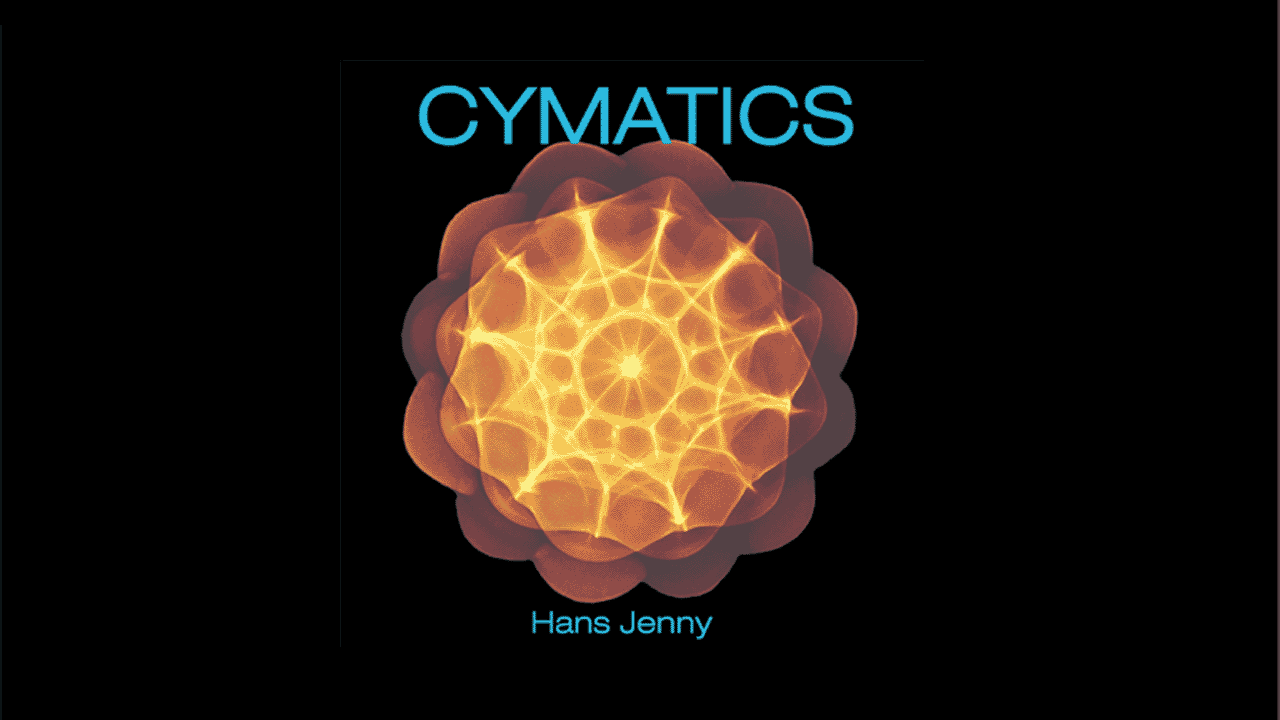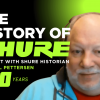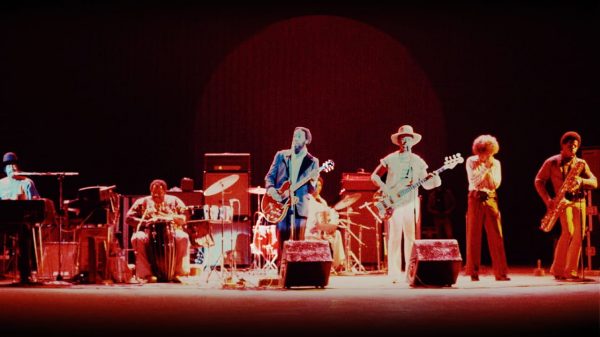Some months ago I shared a video online of Japanese artist Kenichi Kanazawa engaged in an unusual musical performance. Over the next few weeks, this short film clip got more than 12 million impressions on Twitter (since removed, embedded from YouTube below).
The short video is absolutely riveting—despite its stark, unadorned and under-produced quality. It shows Kanazawa in an empty room, spreading white sand on a steel tabletop with the use of a sieve, in a random pattern—the kind of mess a child might make toppling the sugar bowl. Then he begins rubbing the edge of the tabletop with a small rubber mallet, producing a repeated high tone at a rate of approximately 120 beats per minute. The friction created by the mallet rubbing against the steel, causes the tabletop to vibrate, and subsequently, the sand to dance across the surface. Gradually the powder forms into a complex star-shaped pattern, beautiful and symmetrical—almost as if carefully constructed by an artist over the course of hours. But this all happens in just a few seconds.
Kanazawa then repeats the process with a larger mallet, producing a lower bell-like tone at a faster tempo. And now the pattern shifts eerily into a circular shape, ornamented with ten symmetrical protruding knobs. Once again, it would take a skilled artisan many hours to create a beautiful sand sculpture of such complexity, but it happens here almost instantaneously in response to these resonant tones.
As this video went viral on the web, I received hundreds of responses from people—many who thought it was a kind of sorcery or magic trick. They felt instinctively that music was something intangible, almost metaphysical—and simply can’t possess the power to rearrange the physical universe in the way demonstrated on the film.
There has to be a gimmick here, no?
But, in fact, the science behind this performance has been known at least since the late 17th century, when Robert Hooke created patterns out of flour with sounds produced by a violin bow. A hundred years later, physicist and musician Ernst Chladni undertook further experimentation on this effect—and even today many call the resulting patterns made from sound by his name, Chladni figures.
These pioneers deserve credit. But most of our knowledge about the scientific scope and aesthetic dimensions of this remarkable process is due to one individual, Dr. Hans Jenny (1904-1972), a Swiss polymath who devoted much of his life to that magical process of transformation by which sound not only becomes visible, but imposes an architectonic order of beauty and precision on the physical universe.
Before Jenny, this was a stunt or amusing demonstration, but he considered it a special field of scientific inquiry, and gave it a name: Cymatics, from the ancient Greek chima, meaning wave. And for Jenny, this scientific discipline could potentially involve much more than just moving particles on a surface, but encompass the full range of periodic systems we see everywhere in nature, from weather patterns to the functioning of organic life.
If we can unlock the mystery of waves and vibrations, Jenny believed, we not only open our eyes to the sublimity of the universe, but might even set off revolutions in everything from medicine to the arts.

In fact, Jenny had been trained as a medical doctor, and treated patients at his Basel clinic—but his devotion to care also led him to make house calls on poor farmers, or even treat their animals. But his skills covered many other disciplines. He could be heard playing organ at church or improvising jazz. He taught science at a Waldorf school in Zurich. He was a student of philosophy, and his research displays a marked phenomenological orientation that deserves close attention on its own merits. Other interests, from art to zoology, drove Jenny on in his quest to understand the organizing periodic principles of both nature and society.
But his most dramatic research focused on making sound visible to the human eye. He invented a new piece of scientific equipment, which he called a tonoscope, that allowed him to pursue these enigmatic transformations with a depth and precision no previous scientist had brought to the field. Under his guiding hand, not only sand and particles, but even fluids could be shown responding to music. In his laboratory, Mozart’s Jupiter Symphony revealed its capacity to reshape liquid into a delicate lace pattern, worthy of an artisan’s workshop. Bach’s “Toccata and Fugue in D Minor” demonstrated its power to create an extraordinary mosaic of byzantine intricacy.
No one had done this with music before. It was almost as if a whole new dimension of composition were being revealed, literally before our eyes.

Yet Jenny was simply helping us grasp the oldest lore of creation myths—where matter is formed by deities and demiurges by means of of their world-making songs. We encounter this story everywhere in the world—Hindu accounts telling of Shiva’s world-making drum, or Australian Aboriginal narratives describing the musical origins of the landscape (even today the pathways in that region of the world are called songlines), or Biblical passages proclaiming the formative Logos. In the early days of Western philosophy, Pythagoras was known to pick up a stone and tell his followers: “This is frozen music.”
Jenny did not invent any of these belief systems, but he gave them a scientific bearing and an empirical reality they had never possessed before. It was almost as if all the grand claims of world-making music, found in virtually every ancient scriptural tradition, had now been translated into the language and clinical practice of science.
And Jenny documented his work on film. The surviving images and clips are so awe-inspiring that you can almost forget this is laboratory research, and believe you have entered the realm of abstract art of the highest purity and intensity. And, in a way, you have. Jenny created a bridge between the two cultures, scientific and humanistic, or a pathway from the left brain to the right brain. Describe it however you will, he forged connections between worldviews that typically exist isolated one from the other.

The photos are so inspiring, it would be easy to forget the conceptual underpinnings of all this. But we shouldn’t. Not long ago, a new theory of consciousness was advanced by Tam Hunt and Jonathan Schooler, a hypothesis that envisions rhythm as the missing link between mind and matter. These researchers remind us that, in a universe in which everything is vibrating and oscillating—both in our bodies and the external environment—our very sense of identity and agency may be a quasi-rhythmic, musical phenomenon. Hunt and Schooler call this their “resonance theory of consciousness.” But the building blocks of this worldview can be found, in embryonic form, in Jenny’s Cymatics.
How much power does sound possess? I’ll share one last story.
A research team at UCLA recently announced their success in reviving a 25-year-old man in a coma merely by the application of pulsating ultrasound. This impressive result emboldened them to try out the procedure with more severely afflicted patients, and they demonstrated further successes with a 56-year-old man who had been minimally conscious for more than 14 months, and began to revive after just two treatments, as well as a 50-year-old woman who been in an even deeper coma for more than two-and-a-half years following cardiac arrest. After the ultrasound treatment, she could recognize objects and respond to spoken commands for the first time in years.

And all this was done with a non-invasive procedure relying solely on sound. In this instance, the ultrasound was created by a small device the size of a coffee cup. They don’t call it a musical instrument, but it’s hard to understand why not. This is the high tech healing music of the 21st century, and its possibilities are only beginning to be tapped.
Hans Jenny would hardly have been surprised by these developments. To some degree he envisioned them long ago.
It’s a tragedy that so little has been done to advance Jenny’s work in the half-century since his death. His name is still barely recognized, both in the world of science and music. Yet more than any other figure of his time, he showed how these two spheres can come together. We should enjoy his legacy. But we also need to build on it.
The above was adapted from Ted Gioia’s foreword to the forthcoming new edition of Cymatics by Hans Jenny, which is being republished in November 2022 with a new translation and several new commentaries.
Ted Gioia is a leading music writer, and author of eleven books including The History of Jazz and Music: A Subversive History. This article originally appeared on his Substack column and newsletter The Honest Broker.














































